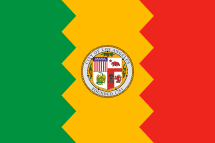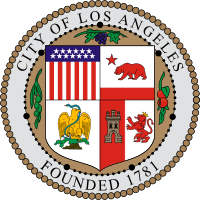Los Angeles Fire Department
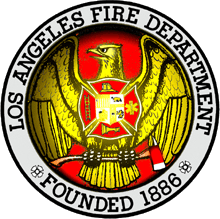 | |
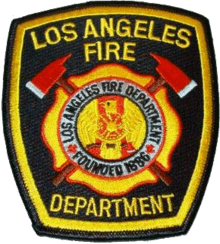 | |
| "Serving With Courage, Integrity, and Pride" | |
| Operational area | |
|---|---|
| Country |
|
| State |
|
| County |
|
| City |
|
| Agency overview[1][2] | |
| Established | February 1, 1886 |
| Annual calls | 406,088 (2013) |
| Employees | 3,574 (2014) |
| Annual budget | $632,940,936 (2016) |
| Staffing | Career |
| Fire chief | Ralph Terrazas |
| IAFF | 112 |
| Facilities and equipment[3][4] | |
| Battalions | 14 |
| Stations | 106 |
| Engines | 92 |
| Trucks | 42 |
| Squads | 8 |
| Rescues | 1 |
| Ambulances | 140 (42 ALS & 34 BLS (24 reserve)) |
| Tenders | 8 |
| HAZMAT | 7 |
| USAR | 5 |
| Airport crash | 8 |
| Wildland | 15 Type 6 & 5 Type 3 |
| Bulldozers | 1 |
| Helicopters | 6 |
| Fireboats | 5 |
| Website | |
| Official website | |
| IAFF website | |
The Los Angeles Fire Department (LAFD) provides firefighting, rescue and emergency medical services for the city of Los Angeles, California, United States.[5] The LAFD is responsible for approximately 4 million people who live in the agency's 471 square miles (1,220 km2) jurisdiction.[6]
The Los Angeles Fire Department founded in 1886 is one of the largest municipal fire departments in the United States, after the New York City Fire Department and the Chicago Fire Department. The department may be unofficially referred to as the Los Angeles City Fire Department or "LA City Fire" to distinguish it from the Los Angeles County Fire Department which serves the county and whose name may directly confuse people, as the county seat is the city, and the city often borders unincorporated counties and contract cities serviced by LACoFD. The department is currently under the command of Fire Chief Ralph Terrazas.
History

The Los Angeles Fire Department has it origins in the year 1871.[7][8][9] In September of that year, George M. Fall, the County Clerk for Los Angeles County organized Engine Company No. 1. It was a volunteer firefighting force with an Amoskeag fire engine and a hose jumper (cart). The equipment was hand-drawn to fires. In the spring of 1874, the fire company asked the Los Angeles City Council to purchase horses to pull the engine. The Council refused and the fire company disbanded.[10]
Many of the former members of Engine Company No. 1 reorganized under the name of Thirty-Eights No. 1 in May 1875, Engine Co. No. 2 was organized under the name Confidence Engine Company.[10]
Los Angeles acquired its first "hook and ladder" truck for the Thirty-Eights. It proved to be too cumbersome and was ill-adapted to the needs of the city. It was sold to the city of Wilmington. In 1876, another "hook and ladder" truck was purchased, serving in the city until 1881.[10]
In 1878, a third fire company was formed by the residents in the neighborhood of Sixth Street and Park. It was given the name of "Park Hose Co. No. 1". East Los Angeles formed a hose company named "East Los Angeles Hose Co. No. 2" five years later. The final volunteer company was formed in the fall of 1883 in the Morris Vineyard area. This company was called "Morris Vineyard Hose Co. No.3."[10]
All of these companies remained in service until February 1, 1886, when the present paid fire department came into existence.[10]
In 1877, the first horses were bought for the city fire department. The department would continue to use horses for its equipment for almost fifty years, phasing out the last horse drawn equipment on July 19, 1921.[11]
By 1900, the Department had grown to 18 fire stations with 123 full-time paid firefighters and 80 fire horses.[11] The city had also installed 194 fire-alarm boxes allowing citizens to sound the alarm if a fire was spotted. 660 fire hydrants were placed throughout the city, giving firefighters access to a reliable water source.[12] In 1955 Station 78 in Studio City became the first racially integrated station in the department.[13]
Los Angeles Fire Department has been contracted to provide fire suppression and EMT services to the city of San Fernando since 1978.[14]
Organization
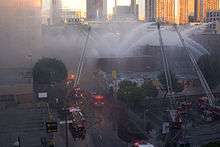
Emergency Operations
The Emergency Operations Section oversees the four geographical suppression Bureaus (Central, South, Valley, and West), which are further divided amongst fourteen battalions, the EMS Section, and the Medical Director.
Central Bureau
The Central Bureau comprises three Battalions, commanding 22 Fire Stations. The Deputy Chief of the Central Bureau is quartered at Fire Station 3, Downtown.
- Battalion 1
- 8 Fire Stations (2, 3, 4, 9, 10, 14, 17, 25)
- Battalion 2
- 8 Fire Stations (1, 12, 16, 42, 44, 47, 50, 55)
- Battalion 11
- 6 Fire Stations (6, 11, 13, 20, 26, 29)
South Bureau
The South Bureau comprises three Battalions, commanding 25 Fire Stations. The Deputy Chief of the South Bureau is quartered at San Pedro City Hall, San Pedro.
- Battalion 6
- 11 Fire Stations (36, 38, 40, 48, 49, 79, 85, 101, 110, 111, 112)
- Battalion 13
- 8 Fire Stations (15, 21, 33, 46, 57, 64, 65, 66)
- Battalion 18
- 7 Fire Stations (34, 43, 58, 61, 68, 92, 94)
Valley Bureau
The Valley Bureau comprises five Battalions, commanding 38 Fire Stations. The Deputy Chief of the Valley Bureau is quartered at Fire Station 83, Encino.
- Battalion 10
- 9 Fire Stations (39, 81, 83, 88, 90, 99, 100, 109, 114)
- Battalion 12
- 7 Fire Stations (7, 24, 74, 75, 77, 91, 98)
- Battalion 14
- 7 Fire Stations (60, 78, 86, 89, 97, 102, 108)
- Battalion 15
- 8 Fire Stations (8, 18, 28, 70, 87, 96, 103, 107)
- Battalion 17
- 7 Fire Stations (72, 73, 84, 93, 104, 105, 106)
West Bureau
The West Bureau comprises three Battalions, commanding 20 Fire Stations. The Deputy Chief of the West Bureau is quartered at Fire Station 82, Hollywood.
- Battalion 4
- 7 Fire Stations (5, 51, 62, 63, 67, 80, 95)
- Battalion 5
- 7 Fire Stations (27, 35, 41, 52, 56, 76, 82)
- Battalion 9
- 6 Fire Stations (19, 23, 37, 59, 69, 71) Station 67 is also in battalion 6's jurisdiction
Administrative Operations
The Administrative Operations section oversees the Employee Relations Division, Risk Management Section, Medical Liaison Unit, Fire Prevention Bureau, the Administrative Services Bureau, the Training and Support Bureau, Metropolitan Fire Communications and the Employee Relations Division.
Operations
Types of apparatus
The department utilizes a wide array of apparatus and equipment. These are most but not all types of fire apparatus utilized by the LAFD.
Triple combination engines

The triple combination fire engine or “triple” (as it is commonly called) is the most common type of firefighting apparatus in Los Angeles. The term “triple combination” refers to the apparatus having three components; water tank, high capacity water pump, and hose. The triple can be found as a one-piece engine company or as two engines assigned to a Task Force station. The “triples” used by the LAFD have several parallel main pumps of varying capacities; 1,000 gpm, 1,250 gpm, 1,500 gpm,and 2,000 gpm at 150 psi. Depending upon the area served, this apparatus may carry a combination of any or all of the following sizes of hose; 4″, 2 1/2″, 1 3/4″, 1 1/2″ and 1″. The water tank carrying capacity ranges from 300 gallons to 500 gallons. These apparatus are staffed by four members, including a Captain 1 as the company commander. A number of triples in the LAFD are also paramedic assessment companies – meaning they include a paramedic as part of the crew.
Light Forces and Task Forces
The LAFD uses the concept of Light Forces and Task Forces which can be considered one "Resource", although comprising more than one unit or company.[15]
A Light Force is composed of a Pump Engine (200 Series, for example Engine 201 or Engine 301 for 100 stations)and a Ladder Truck.[16] Light forces will almost always respond together as one unit or resource.[17]
A Task Force is simply a Light Force coupled with an Engine. An Engine is considered a single unit or "resource" when responding to incidents on its own.[16] A Task Force usually responds to larger incidents, such as structural fires, and is made up of an Engine, a 200 Series Pump Engine, and a Truck, all operating together. While a standard Engine is always staffed with a full crew, a 200 Series Pump Engine is only staffed by a driver (and one other firefighter if responding as part of a Task Force). The purpose of the 200 Series Pump Engine is to provide support and equipment to the Truck in a Light Force, and either the Truck or the Engine in a Task Force.[18]
Rescue Ambulances
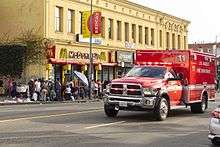
Rescue Ambulances (RAs), often called 'rescues' for short, can be considered either advanced life support (ALS), or basic life support (BLS). Ambulances number 1-112 are frontline ALS staffed by 2 firefighter / paramedics, while those in the 200 series are ALS reserves.[19] Ambulances in the 800s are BLS staffed by 2 firefighter EMT's, while those in the 900s are BLS reserves.[19]
Helicopters
.jpg)
The Air Operations division of the LAFD operates out of Fire Station 114 at Van Nuys Airport. The division has six helicopters available for both aerial firefighting and air medical services. Copter 1 and Copter 4 are both Bell 412s.[20][21] Copter 2, Copter 3 and Copter 5 are all AgustaWestland AW139s.[22][23][24] The final helicopter, Copter 6, is a Bell 206B.[25]
Fireboats

The Port of Los Angeles is under the jurisdiction of the LAFD which operates 5 fireboats to provide fire protection for ships and dockside structures.[26] Fireboat 1, Fireboat 3 and Fireboat 5 are identical 39-foot (12 m) long aluminum fireboats capable of a top speed of 29 knots (33 mph; 54 km/h) while fully loaded.[27] They are equipped with a 2,400 US gal/min (9,100 L/min) pump and a 1,000 US gal/min (3,800 L/min) deluge gun.[27] They also have a 50-US-gallon (190 L) firefighting foam capacity.
Fireboat 4, also known as the Bethel F. Gifford, was commissioned in 1962 and is the oldest of the fleet. It is capable of pumping water at 9,000 US gal/min (34,000 L/min) and carries 550 US gallons (2,082 L) of foam solution for petrochemical fires.[28] It is equipped with jet-stream nozzles to allow for increased maneuverability.[28]
The newest and most technologically advanced of the fireboats is the 105-foot (32 m) long Fireboat 2, also known as the Warner Lawrence, which has the capability to pump up to 38,000 US gallons per minute (140,000 L/min) up to 400 feet (120 m) in the air.[29] Boat 2 also has an onboard area for treatment and care of rescued persons.[30]
USAR Task Force 1
The Los Angeles Fire Department is the founding member of one of California's eight FEMA Urban Search and Rescue Task Forces.[31] California Task Force 1 (CA-TF1) is available to respond to natural or man-made disasters around the county and world and assist with search and rescue, medical support, damage assessment and communications.[32]
Heavy Rescue
The LAFD operates a specialized tow-truck as a "Heavy Rescue" out of Fire Station 3 in downtown Los Angeles. This apparatus is useful in a wide variety of situations, including but not limited to righting overturned big rigs, pulling crushed vehicles apart, and lifting heavy objects.[33]
Closed Fire Stations
- Fire Station 22 - 4366 S. Main St. (Closed 1/22/1980)
- Fire Station 30 - 1401 S. Central Ave. (Closed 1980) (Now African American Firefighter's Museum)
- Fire Station 31 - 700 W. Slauson Ave. (Closed 1971)
- Fire Station 32 - 2930 Beverly Blvd. (Closed 7/1/1972)
- Fire Station 45 - 947 S. Norton Ave. (Closed 1987)
- Fire Station 53 - 438 N. Mesa St. (Closed 1986) (Engine 53 became Engine 112)
- Fire Station 54 - 5730 Crenshaw Blvd. (Closed 9/20/1989)
In pop culture
The LAFD has been featured in many TV shows and movies. Sometimes the LAFD or LAFD equipment is just seen in the background.
- (1962) The Story of a Fireman (David L Wolper TV series), Directed by Academy Award winner Terry Sanders.
- (1974) Firehouse, starring James Drury
- (1981–1982) Code Red, starring Lorne Greene
- (1995–2000) "LAPD Life On The Beat (Reality TV show)" , the fire department was featured often responding to various emergency calls with the "LAPD".
- (1999) Rescue 77
- (2008) Quarantine, LAFD as the "Los Angeles Fire Rescue".
- (2015) San Andreas
- (2018) 9-1-1 (US TV Series)
The Los Angeles Fire Department is featured in Grand Theft Auto V and Grand Theft Auto: San Andreas as the Los Santos Fire Department (LSFD).
See also
- Engine Company No. 28
- Engine House No. 18 (Los Angeles, California)
- Fire Station No. 14 (Los Angeles, California)
- Fire Station No. 23 (Los Angeles, California)
- Fire Station No. 30, Engine Company No. 30
- Los Angeles Fire Department Museum and Memorial
- Louis R. Nowell, fire captain who became a City Council member
- Ralph J. Scott, formerly known as Fireboat #2
- The Stentorians Fire Station No.46
References
- ↑ "Budget 2014-2015" (PDF). City of Los Angeles. p. 18. Retrieved 15 February 2015.
- ↑ "Fire Chief". Los Angeles Fire Department.
- ↑ "Find Your Station". Los Angeles Fire Department. Retrieved 28 October 2017.
- ↑ "Apparatus". California Firefighters. Retrieved 2 March 2015.
- ↑ "Welcome to the Los Angeles Fire Department". Lafd.org. Retrieved 2014-02-07.
- ↑ "About the LAFD". Los Angeles Fire Department. Retrieved February 20, 2007.
- ↑ "LAFD History". Lafd.org. Retrieved 2014-02-07.
- ↑ "LAFD History". Lafd.org. Retrieved 2014-02-07.
- ↑ "The Origins of the LAFD". Lafd.org. Retrieved 2014-02-07.
- 1 2 3 4 5 "The Volunteers, 1871 to 1885". Los Angeles Fire Department Historical Archive. Retrieved September 5, 2006.
- 1 2 "The Era of the Horses 1886 to 1921". Los Angeles Fire Department Historical Archive. Retrieved September 5, 2006.
- ↑ "The Era of the Horses 1886 to 1921". Los Angeles Fire Department Historical Archive. Archived from the original on September 2, 2006. Retrieved September 5, 2006.
- ↑ Company, Johnson Publishing (January 13, 1955). "Los Angeles Ends Jim Crow Fire Department". Jet. 7 (10). Retrieved August 29, 2011.
- ↑ Santana, Miguel A. (2013). "AGREEMENT FOR COMPREHENSIVE FIRE AND EMERGENCY MEDICAL SERVICES FOR THE CITY OF SAN FERNANDO" (PDF). City of Los Angeles Office of the City Clerk. City of Los Angeles.
- ↑ "Apparatus | Los Angeles Fire Department". www.lafd.org. Retrieved 2017-10-28.
- 1 2 "Deployment Plan" (PDF). The South Robertson Neighborhoods Council. Retrieved 3 March 2015.
- ↑ "Apparatus | Los Angeles Fire Department". www.lafd.org. Retrieved 2017-10-28.
- ↑ "Apparatus | Los Angeles Fire Department". www.lafd.org. Retrieved 2017-10-28.
- 1 2 "EMS Resources". Los Angeles Fire Department. Retrieved 3 March 2015.
- ↑ "N301FD". FAA. Retrieved 3 March 2015.
- ↑ "N304FD". FAA. Retrieved 3 March 2015.
- ↑ "N302FD". FAA. Retrieved 3 March 2015.
- ↑ "N303FD". FAA. Retrieved 3 March 2015.
- ↑ "N301FD". FAA. Retrieved 3 March 2015.
- ↑ "N306FD". FAA. Retrieved 3 March 2015.
- ↑ "Fire Stations". Port of Los Angeles. Retrieved 4 March 2015.
- 1 2 "Fireboats 1, 3 & 5". Los Angeles Fire Department Historical Archive. Retrieved 4 March 2015.
- 1 2 "Fireboat 4". Los Angeles Fire Department Historical Archive. Retrieved 4 March 2015.
- ↑ "Fireboat 2". Los Angeles Fire Department Historical Archive. Retrieved 4 March 2015.
- ↑ "Los Angeles Fire Department New Fireboat Fleet Dedication" (Press release). Los Angeles Fire Department. March 28, 2003. Retrieved 2006-09-05.
- ↑ "Task Force Locations". FEMA. Retrieved 29 January 2015.
- ↑ "Los Angeles Fire Department Urban Search and Rescue" (PDF). Fire Watch. 2 (3). March 2005. Retrieved 2 March 2015.
- ↑ "Apparatus | Los Angeles Fire Department". www.lafd.org. Retrieved 2017-10-28.
External links
| Wikimedia Commons has media related to Los Angeles Fire Department. |
_edit1.jpg)
